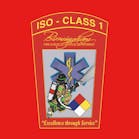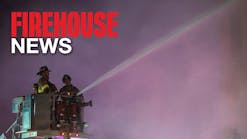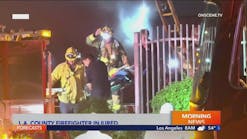As we all know, seconds count when a firefighter becomes lost or trapped in a burning building. Taking steps to reduce this time wherever we can will increase the chances of survival for the firefighter in trouble. Rapid Intervention Teams must be pro-active while on the fireground. Performing building and fire condition size ups on a periodic basis during the incident should be standard protocol for the RIT.
A pro-active procedure such as setting up and maintaining a pool of firefighter rescue equipment near the incident, versus running for this equipment when a mayday is declared is good rapid intervention management. A series of staging levels is incorporated into the RIT standby to better manage the operations.
Level 1 Staging
A level 1 staging operation would be for "routine" room and contents fires that are held to one alarm, a smaller fire. This type fire is usually under control within 15 to 20 minutes requiring the use of one or two attack lines. Statistically, the most dangerous time on the fireground is within the first 20 minutes of arrival. With a quick dispatch of a RIT on the first alarm of reported structure fires, a firefighter rescue team would arrive well before this time frame expires.
During a level 1 staging operation the RIT would report to command and stage in front of the building, (trying to maintain a view of at least two sides of the fire building). The team should have with them; basic forcible entry tools, full PPE and SCBA, handlights, RIT bag (if used), a thermal imaging camera (if available), and an SCBA rescue pack. This level of staging will usually be short in nature time wise and would not require the action of setting up a formal staging area.
Level 2 Staging
A level 2 staging operation would be for one alarm fires that escalate into a two alarm or greater incident, a larger fire. Additionally, a fire that would advance to a second alarm before the arrival of the RIT would advance to a level 2 staging operation. This type of incident is inherently more dangerous to firefighters and would require a more pro-active standby.
The length of on scene time increases, structural integrity of the fire building weakens, firefighters work strenuously at initial on scene tasks reducing their stamina. Engine crews advance deeper into smoke filled structures locating the seat of the fire, truck crews are spending more time on the roof, and SCBA air supplies are often stretched to the low air alarm.
All of these situations and more make for a more perilous fireground with accidents and dangerous situations lurking in the shadows. It is within this type of incident that our firefighter rescue teams must be vigilant and ready to deploy at a moment's notice.
Having a formal equipment staging area during this type of incident will increase the RIT's ability to deploy on a mayday. This level of standby adds more specialized rescue equipment to the teams arsenal requiring the use of a salvage tarp placed on the ground to better control and maintain this equipment pool. This tarp will also notify suppression firefighters that this equipment is for use by the RIT only in the event of a mayday.
Equipment such as a chainsaw and circular saw with a metal cutting blade. Having these saws immediately available to the RIT will enable them to quickly perform an enlarged opening on a structure to remove firefighters or cut steel security bars from windows for immediate firefighter escape. This staging level would also require the team to secure a power source for providing electrical power to specialized rescue equipment such as sawzalls, electric chainsaws, or lighted search rope.
In addition, the team would make arrangements for a protective hoseline to be available to advance behind the team if they deploy into the structure on a mayday. I have observed some teams purchase bright orange tarps with reflective trim for use as the staging tarp. This simply is one more way to further identify that the tools and equipment on this tarp are designated for firefighter rescue operations only. The use of a tarp is not required but certainly helps to control the pool of equipment being placed in one area.
Level 3 Staging and Task Force Operations
The level 1 or 2 staging would advance to level 3 staging for any of the following reasons:
- An actual "mayday" has been declared
- A firefighter or company is reported missing and the RIT deploys
- A PASS device has activated that cannot be identified or located and the RIT deploys.
The initial standby team would deploy into the structure and two additional Rapid Intervention Teams, or a Rapid Intervention Task Force, would be dispatched immediately. It is best if this task force is on scene before the mayday occurs.
A way of having this task force on scene early on is to have it dispatched on the implementation of a level 2 staging operation. It is a proven fact through training and case studies of actual firefighter rescues that a tremendous amount of manpower is needed to find, extricate, and remove a downed firefighter from a burning building.
Often as much as 10 to 12 firefighters may be needed to rescue just one downed firefighter. This extra manpower could be the difference between life and death of a trapped firefighter. If the downed firefighter has become trapped or pinned by an object or debris, the initial RIT will more than likely NOT complete the removal. Their air supplies and stamina will become depleted before the firefighter is rescued.
Having the back up teams in place will drastically increase the chances of survival for the downed firefighter. It is more important to have this extra manpower on scene where they are needed the most versus having to respond to the scene wasting critical time.
When the two additional RIT's arrive on the scene, one team (RIT 2) will prepare to enter the structure and assist RIT 1 with the firefighter rescue. They may also be ready to assist from the exterior of the building by creating enlarged openings or setting up mechanical advantage lowering systems for removal from elevated locations.
The other additional team (RIT 3) will work to move specialized rescue and EMS equipment from the apparatus on scene to the forward RIT staging tarp. This will save valuable time in getting this equipment inside to the victim if the initial team finds the downed firefighter in an entrapment situation. RIT 3 will then standby and protect the remaining fireground and prepare to support RIT 1 and 2.
You should now have a staff of at least 10 to 13 firefighters on scene to deal directly with the mayday. If needed, additional Rapid Intervention Task Forces can be dispatched to the scene to assist with the downed firefighter operations.
This RIT staging operation should be the basic minimum procedure used on any fireground. Certainly if you have a larger response plan in place continue with what is working for you. Having a larger Rapid Intervention response to any incident is a plus when it comes time to deploy on a mayday.
Most fire departments simply do not have these resources immediately available to them. This is not to say that a plan could not be devised and implemented with some pre-planning and joint cooperation with your mutual aid fire departments. For larger career departments, this RIT task force concept and staging level plan should not be an issue. For both the career and volunteer sectors, it's simply an attitude, whether positive or negative regarding your firefighter rescue operations.
The task force can be dispatched automatically on the finding of a working fire or an additional alarm being struck. This task force could include an additional engine, truck, and rescue company devoted to RIT to arrive on scene and assist the initial standby team with rapid intervention duties such as implementing the RIT staging levels.
However you decide to set up your RIT response, keep in mind that when a mayday occurs, it happens very quickly and will catch everyone off guard. If you do not have a solid rapid intervention plan in place right then and there, chances are you will not catch up to the rescue operation.
The emergency actions involving a mayday will most likely be over within 20 minutes of the distress call. If you have to call for the task force after the mayday is sounded, you will already be behind for this event. Personally, I would rather not be throwing Hail Mary passes during a firefighter rescue. But rather planned, precise, and logical decisions that will save the firefighters life.
Conclusion
Not every procedure, guideline, or plan will work for every fire department. Each individual organization must plan and develop a firefighter rescue program that is tailored to suit their needs, response area, and building construction. But remember, firefighter rescue is extremely labor intensive regardless of where you are located. Bottom line is this. Fire buildings kill firefighters. Mix that with a combination of untrained rescue teams, inadequate rescue equipment, poor or no rapid intervention procedures, and lack of a priority in RIT and you are surely setting yourself up to be hosting a firefighter funeral. The Rapid Intervention Task Force concept is a viable way of having or getting manpower to the scene quickly to increase the chances of survival for our people in trouble. Rapid Intervention staging levels are another way of putting the resources we need close to the area it is needed most. Lets all give each other the upper hand at survival if we become lost, trapped, or disoriented within a fire building and initiate new procedures or revise old ones.
Remember, change can be good?
James K. Crawford is a firefighter with the Pittsburgh Bureau of Fire assigned to Truck Company #33 and a contributing editor for Firehouse Magazine and Firehouse.com. He is a Fire Suppression Instructor for the Pennsylvania State Fire Academy and the Assistant Chief of Training for the 171st Air Refueling Wing Fire Department, Pennsylvania Air National Guard-Pittsburgh. He is a graduate of the Pittsburgh Fire Academy and the Air Force Fire Academy spending four years on active duty as a firefighter. He has over 23 years experience in the career and volunteer fire service. Jim lectures nationally on the subject of Rapid Intervention Teams and is the President of Rapid Intervention Training Associates and founder of RapidIntervention.Com




